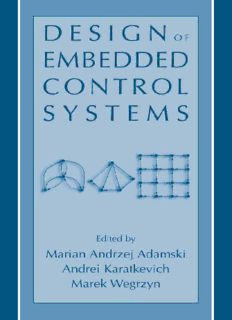
Design of Embedded Control Systems PDF
Preview Design of Embedded Control Systems
Design of Embedded Control Systems Design of Embedded Control Systems Marian Andrzej Adamski Andrei Karatkevich and Marek Wegrzyn UniversityofZielonaGora,Poland LibraryofCongressCataloging-in-PublicationData Designofembeddedcontrolsystems/MarianAndrzejAdamski,AndreiKaratkevich, MarekWegrzyn[editors]. p. cm. Includesbibliographicalreferencesandindex. ISBN0-387-23630-9 1.Digitalcontrolsystems—Designandconstruction. 2.Embeddedcomputersystems—Design andconstruction. I.Adamski,M.(Marian) II.Karatkevich,Andrei. III.Wegrzyn,M.(Marek) TJ223.M53D472005 629.8—dc22 2004062635 ISBN-10:0-387-23630-9 Printedonacid-freepaper. ISBN-13:978-0387-23630-8 (cid:1)C 2005SpringerScience+BusinessMedia,Inc. Allrightsreserved.Thisworkmaynotbetranslatedorcopiedinwholeorinpartwithoutthewritten permissionofthepublisher(SpringerScience+BusinessMedia,Inc.,233SpringStreet,NewYork, NY10013,USA),exceptforbriefexcerptsinconnectionwithreviewsorscholarlyanalysis.Usein connectionwithanyformofinformationstorageandretrieval,electronicadaptation,computersoftware, orbysimilarordissimilarmethodologynowknownorhereafterdevelopedisforbidden. Theuseinthispublicationoftradenames,trademarks,servicemarksandsimilarterms,eveniftheyarenot identifiedassuch,isnottobetakenasanexpressionofopinionastowhetherornottheyaresubjectto proprietaryrights. PrintedintheUnitedStatesofAmerica (TB/IBT) 9 8 7 6 5 4 3 2 1 springeronline.com About the Editors Marian Andrzej Adamski received an M.Sc. degree in electrical engi- neering (specialty of control engineering) from Poznan Technical Univer- sity, Poland, in 1970; a Ph.D. degree in control and computer engineering from Silesian Technical University, Gliwice, Poland, in 1976; and a D.Sc. in computer engineering from Warsaw University of Technology, Poland, in 1991. After completing his M.Sc. in 1970, he joined the research laboratory in NuclearElectronicsCompanyinPoznan.In1973hebecameaseniorlecturer attheTechnicalUniversityofZielonaGo´ra,Poland.From1976to1991hewas employedasanassistantprofessor,andlaterfrom1991to1992asanassociate professor.From1993to1996hewasavisitingprofessoratUniversityofMinho, in Braga and Guimaraes, Portugal. Currently he is a full-tenured professor of computer engineering at University of Zielona Go´ra, Poland. He is a chair of ComputerEngineeringandElectronicsInstituteatUniversityofZielonaGo´ra. Prof. Adamski’s research includes mathematical logic and Petri nets in digital systems design, formal development of logic controller programs, and VHDL,FPLD,andFPGAinindustrialapplications. Prof.M.Adamskiisanauthorofmorethan160publications,includingsix books, and he holds five patents. He is a member of several international and nationalsocieties,includingCommitteesofPolishAcademyofSciences,Polish ComputerScienceSociety,AssociationforComputingMachinery(ACM),and TheInstituteofElectricalandElectronicsEngineers(IEEE).Hehassupervised morethan100M.Sc.thesesandseveralPh.D.dissertations.Hehasbeenaprin- cipalinvestigatorforgovernment-sponsoredresearchprojectsandaconsultant to industry. He is a member of the editorial board of International Journal of Applied Mathematics and Computer Science and a referee of international conferences and journals. He has been involved as a program and organizing committeememberofseveralinternationalworkshopsandconferences.Heob- tainedtheScientificAwardfromMinistryofHigherEducationandwonseveral timestheUniversityDistinguishedTeachingandResearchawards. vi AbouttheEditors Andrei Karatkevich received a master’s degree in system engineering (1993)fromMinskRadioengineeringInstitute(Belarus)andPh.D.(1998)from BelarusianStateUniversityofInformaticsandRadioelectronics(Minsk).From 1998to2000hewasemployedatthisuniversityasalecturer.Since1999hehas beenworkingatUniversityofZielonaGo´ra(Poland)asanAssistantProfessor. Dr.Karatkevichteachesavarietyofclassesincomputerscienceandcomputer engineering. His research interest includes digital design, theory of logical control.Petrinets,analysisandverificationofconcurrentalgorithms,discrete systemsandgraphtheory.Hehaspublished40+technicalpapersandseveral researchpresentations. MarekWegrzynreceivedanM.Sc.inelectricalengineering(summacum laude) from the Technical University of Zielona Go´ra, Poland, in 1991. Since 1991 he has been a lecturer of digital systems in Computer Engineering and Electronics Department, Faculty of Electrical Engineering at the university. He spent one academic year (1992–93) at University of Manchester Institute ofScienceandTechnology(UMIST),Manchester,UK,workingonVLSIde- sign and HDLs (Verilog and VHDL). He has been a visiting research fellow in the Department of Industrial Electronics, University of Minho, Braga and Guimaraes,Portugal(in1996).HereceivedhisPh.D.incomputerengineering from the Faculty of Electronics and Information Techniques at Warsaw Uni- versity of Technology, Poland, in 1999. Currently, Dr. Marek Wegrzyn is an assistant professor and head of Computer Engineering Division at University ofZielonaGo´ra,Poland. His research interests focus on hardware description languages, Petri nets, concurrent controller designs, and information technology. His recent work includes design of dedicated FPGA-based digital systems and tools for the automatic synthesis of programmable logic. He is a referee of international conferencesandjournals. Dr. Marek Wegrzyn was the 1991 recipient of the Best Young Electrical Engineer award from District Branch of Electrical Engineering Society. As the best student he obtained in 1989 a gold medal (maxima cum laude) from the rector-head of the Technical University of Zielona Go´ra, a Primus Inter Paresdiploma,andtheNicolausCopernicusAwardfromtheNationalStudent Association. He won the National Price from Ministry of Education for the distinguished Ph.D. dissertation (2000). He obtained several awards from the rector-head of the University of Zielona Go´ra. He has published more than 70papersinconferencesandjournals.Hewasacoeditoroftwopostconference proceedings. Foreword A set of original results in the field of high-level design of logical control devicesandsystemsispresentedinthisbook.Theseconcerndifferentaspects of such important and long-term design problems, including the following, whichseemtobethemainones. First,thebehaviorofadeviceunderdesignmustbedescribedproperly,and some adequate formal language should be chosen for that. Second, effective algorithmsshouldbeusedforcheckingtheprepareddescriptionforcorrectness, foritssyntacticandsemanticverificationattheinitialbehaviorlevel.Third,the problem of logic circuit implementation must be solved using some concrete technological base; efficient methods of logic synthesis, test, and verification should be developed for that. Fourth, the task of the communication between thecontroldeviceandcontrolledobjects(andmaybebetweendifferentcontrol devices)waitsforitssolution.Alltheseproblemsarehardenoughandcannotbe successfully solved without efficient methods and algorithms oriented toward computerimplementation.Someofthesearedescribedinthisbook. The languages used for behavior description have been descended usually from two well-known abstract models which became classic: Petri nets and finite state machines (FSMs). Anyhow, more detailed versions are developed and described in the book, which enable to give more complete information concerningspecificqualitiesoftheregardedsystems.Forexample,themodelof parallelautomatonispresented,whichunliketheconventionalfiniteautomaton canbeplacedsimultaneouslyintoseveralplaces,calledpartial.Asabasefor circuitimplementationofcontrolalgorithms,FPGAisacceptedinmajorityof cases. Hierarchical Petri nets have been investigated by Andrzejewski and Miczulski,whoprovetheirapplicabilitytodesignofcontroldevicesinpractical situations. Using Petri nets for design and verification of control paths is sug- gested by Schober, Reinsch, and Erhard, and also by We¸grzyn and We¸grzyn. Anewapproachtomodelingandanalyzingembeddedhybridcontrolsystems, based on using hybrid Petri nets and time-interval Petri nets, is proposed by viii Foreword Hummel and Fengler. A memory-saving method of checking Petri nets for deadlocks and other qualities is developed by Karatkevich. A special class of reactivePetrinetswithmacronodesisintroducedandthoroughlyinvestigated (Gomes, Barros, and Costa). Using Petri nets for reactive system design was workedoutbyAdamski. ThemodelofsequentautomatonwassuggestedbyZakrevskijfordescrip- tionofsystemswithmanybinaryvariables.Itconsistsofso-calledsequents— expressionsdefining“cause-effect”relationsbetweeneventsinBooleanspace of input, output, and inner variables. A new method for encoding inner FSM states, oriented toward FSM decomposition, is described (Kuba´tova´). Several algorithmsweredevelopedforassignmentofpartialstatesofparallelautomata: for using in the case of synchronous automata (Pottosin) and for the asyn- chronous case, when race-free encoding is needed (Cheremisinova). A new technique of state exploration of statecharts specifying the behavior of con- (cid:1) trollers is suggested by Labiak. Awide variety of formal languages is used in theobject-orientedreal-timetechniquesmethod,thegoalofwhichisthespeci- ficationofdistributedreal-timesystems(Lopes,Silva,Tavares,andMonteiro). TheproblemoffunctionaldecompositionistouchedbyBibiloandKirienko, who regarded it as the task of decomposing a big PLA into a set of smaller (cid:1) ones,andbyRawski,Luba,Jachna,andTomaszewicz,whoappliedittocircuit implementationinCPLD/FPGAarchitecture. Someotherproblemsconcerningthearchitectureofcontrolsystemsarealso discussed. Architectural Description Language for using in design of embed- dedprocessorsispresentedbyTavares,Silva,Lima,Metrolho,andCouto.The influenceofFPGAarchitecturesonimplementationofPetrinetspecifications is investigated by Soto and Pereira. Communication architectures of multi- processor systems are regarded by Dvorak, who suggest some tools for their improving. A two-processor (bit-byte) architecture of a CPU with optimized interactionissuggestedbyChmielandHrynkiewicz. Anexampleofapplicationofformaldesignmethodswithestimationoftheir effectivenessisdescribedbyCaban,whosynthesizedpositionaldigitalimage filtersfromVHDLdescriptions,usingfieldprogrammabledevices.Inanother example,atechnologyofdevelopmentandproductizationofvirtualelectronic components, both in FPGA and ASIC architectures, is presented (Sakowski, Bandzerewicz,Pyka,andWrona). A.Zakrevskij Contents AbouttheEditors v Foreword vii SectionI:SpecificationofConcurrentEmbeddedControlSystems 1. UsingSequentsforDescriptionofConcurrentDigital SystemsBehavior 3 ArkadijZakrevskij 2. FormalLogicDesignofReprogrammableControllers 15 MarianAdamski 3. HierarchicalPetriNetsforDigitalControllerDesign 27 GrzegorzAndrzejewski SectionII:AnalysisandVerificationofDiscrete-EventSystems 4. WCETPredictionforEmbeddedProcessorsUsinganADL 39 Adriano Tavarev / Carlos Silva / Carlos Lima / Jose´ Metrolho / CarlosCouto 5. VerificationofControlPathsUsingPetriNets 51 TorstenSchober/AndreasReinsch/WernerErhard 6. Memory-SavingAnalysisofPetriNets 63 AndreiKaratkevich x Contents 7. SymbolicStateExplorationofUMLStatechartsforHardware Description 73 (cid:1) GrzegorzLabiak 8. CalculatingStateSpacesofHierarchicalPetriNetsUsing BDD 85 PiotrMiczulski 9. ANewApproachtoSimulationofConcurrentControllers 95 AgnieszkaWe¸grzyn/MarekWe¸grzyn SectionIII:SynthesisofConcurrentEmbeddedControlSystems 10. OptimalStateAssignmentofSynchronousParallelAutomata 111 YuryPottosin 11. OptimalStateAssignmentofAsynchronousParallelAutomata 125 LjudmilaCheremisinova 12. DesignofEmbeddedControlSystemsUsingHybridPetriNets 139 ThorstenHummel/WolfgangFengler SectionIV:ImplementationofDiscrete-EventSystems inProgrammableLogic 13. StructuringMechanismsinPetriNetModels 153 Lu´ısGomes/Joa˜oPauloBarros/Aniko´ Costa 14. ImplementingaPetriNetSpecificationinaFPGAUsingVHDL 167 EnriqueSoto/MiguelPereira 15. FiniteStateMachineImplementationinFPGAs 175 HanaKuba´tova´ 16. BlockSynthesisofCombinationalCircuits 185 PyotrBibilo/NataliaKirienko 17. TheInfluenceofFunctionalDecompositiononModernDigital DesignProcess 193 (cid:1) MariuszRawski/TadeuszLuba/ZbigniewJachna/ Pawel(cid:1)Tomaszewicz
Description: